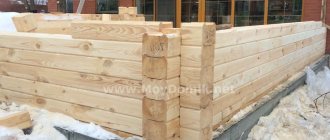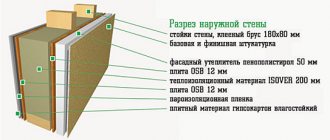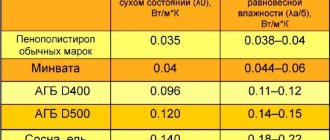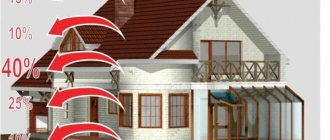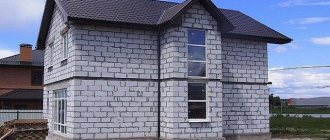Among other types of building materials used in the construction of the frame of a private house, foam concrete blocks are distinguished by their low cost, low thermal conductivity and low weight. Due to the extreme simplicity of the manufacturing technology, they can be made directly on the site in the utility room.
However, to build your own personal cottage, it is better to purchase foam blocks in a factory-made version with standard sizes and the brand required for a particular case. It is recommended to take some foam concrete products for external walls, and others for internal partitions.
What is a foam concrete block?
Foam block is a porous building material made from a mixture of cement, water with sand and a foaming agent. This is one of the varieties of cellular concrete (foam concrete). But unlike aerated concrete, which is similar in structure, voids in it are formed not due to chemical reactions inside the block during the hardening process, but due to the mixing of the concrete mixture with pre-prepared foam.
The foaming agent used is organic or synthetic. The first protein-based option is more expensive, but the block with it is more durable and environmentally friendly. Synthetics are cheap, but have a 4th hazard class. The foam blocks themselves are safe, but you have to be more careful when mixing the solution when working with the original mixture.
Forms for pouring foam concrete mixture
This material for building houses is produced in two ways:
- By cutting a monolith of hardened foam concrete into “bricks” of the required size;
- Filling forms with the required dimensions in width, height and length.
The process of sawing an array of hardened foam concrete into blocks
To save on raw materials and increase the density of the blocks, ash, clay and other bulk fine-grained materials are often added to the mixture when mixing. On the one hand, this allows a significant reduction in cement consumption, and on the other hand, it leads to thickening of the interpore walls inside the foam block, making the product more durable. Moreover, the size of internal voids in this case decreases, increasing the thermal conductivity of the material.
Appearance
HOW TO CHOOSE THE SUITABLE FOAM BLOCK
Table of foam concrete sizes and material consumption for masonry
First of all, you need to decide what size blocks you need. If the masonry is carried out independently, then large-format blocks will not be suitable, because 1-2 people cannot handle them.
For example, when I built a house from foam blocks, there was no need to use a block larger than 20*30*60 cm.
In answer to the question “which foam blocks are best to build a house from” it is difficult to give a definite answer. The thing is that the usual M marking is not used in relation to this material. Unlike brick, for example, the brand of foam block does not indicate its strength, but its density.
That is, looking at the number after the letter M in the brand of brick, you can understand how many kg per unit area it can withstand. In foam concrete, markings are carried out with numbers from 400 to 1200 after the letter D.
The number tells how many kilograms a cubic meter of brick weighs. Pay close attention to the photo below. The price, as you understand, will increase in proportion to the increase in brand.
Table of density in relation to concrete
If you take this point into account in your foam block house project, you will save yourself from unnecessary hassle, and you will not have to invest in subsequent repairs.
As you understand, it is impossible to say which foam blocks are better in principle. It is necessary to understand that each has its own use and use it correctly.
Types and sizes of foam blocks
One of the main characteristics of a foam concrete block in its marking is indicated by the letter “B” and a number from 0.5 to 60. This is an indicator of strength, i.e. load in kg/cm2 that a given foam block is able to withstand during compression. The higher this index, the more weight the building material in question can support without destroying its integrity. If a two-story house is being built, then it is best to take blocks with the highest possible strength for the first floor, and lower ones for the second.
The first parameter is directly related to the brand of foam concrete “M” in the same marking. The figure in its designation is calculated using the formula “strength value B” * 10/0.7, rounded to the nearest whole number. The second criterion in the classification is their average density (MPa), which is expressed in the product name by the letter “D” and a value from 300 to 1200.
Based on density and purpose, they are divided into three groups:
- Thermal insulation - D300 (B0.35 or B0.75), D400 (B0.75; B1 or B2) and D500 (B1.5; B2; B2.5 or B3.5).
- Structural and thermal insulation – D600 (B2; B2.5; B3.5 or B5), D700 (B2; B2.5; B3.5 or B5), D800 (B2.5, B3.5, B5 or B7.5) and D900 (B2.5; B3.5; B5 or B7.5).
- Structural – D1000 (B5 or B7.5), D1100 (B7.5 or B10) and D1200 (B10 or B12.5).
The frost resistance of foam blocks is designated from F15 to F75. Products marked F15–F25 are intended for the construction of internal partitions of a house, and from F25 and above are already recommended for the construction of external walls.
Depending on the average density and size, foam concrete blocks are divided into 10 types with markings from I to X. For example, a type “I” foam block has the following dimensions: height 188 mm, width 300 mm and length 588 mm. In terms of density, it can be made with the grade D500, D600 or D700. For a block of type “V”, GOST establishes dimensions of 288x250x288 mm and any class D from 300 to 1200. And the foam concrete product “X” has overall dimensions of 88x200x398 mm and a density of only D1200.
Foam block sizes
Foam block size table
| Dimensions, mm | Pieces per 1 cubic meter | Quantity on pallet | Quantity in masonry per 1 sq. m |
| 600x300x100 | 55 | 80 | 16,7 |
| 600x300x120 | 46 | 64 | 13,8 |
| 600x300x150 | 37 | 48 | 11,2 |
| 600x300x200 | 27 | 40 | 8,4 |
| 600x300x250 | 22 | 32 | 6,7 |
Determination of wall thickness
Before determining the thickness of the walls, you need to familiarize yourself with the technical characteristics of the material:
- light weight;
- density;
- price;
- simple fixation methods;
- compressive strength from 3.5 to 5 MPa, which allows the construction of buildings with two and three floors;
- thermal conductivity, due to which heat is retained in the house much longer with relatively thin walls;
- good sound insulation, which is often enough without an additional layer.
The higher the density of the foam block, the more expensive it is.
Foam concrete walls have their pros and cons. But you can only get all the negative qualities by purchasing expensive foam blocks. If low-quality materials are used during construction, this will not only negatively affect the quality of life in the house and comfort, but may even cause the destruction of the house.
Outdoor
To determine the appropriate thickness of external walls, the following parameters must be taken into account:
- find out to what temperature the temperature in the region of residence drops; if the indicators are unstable, then you will need to equip the house with additional insulation;
- choose the type of insulation that is best suited for the house; in some cases, such insulation is not even required and one plaster will be enough;
- if the wall made of foam blocks in the apartment is thinner than 300 mm, then you will need to install additional insulation no more than 100 mm thick;
- insulation performs two functions at once: it retains heat in the house and does not allow ultraviolet radiation to penetrate to the foam blocks, which under the influence of such radiation can change their structure.
You cannot purchase cheap foam blocks, as they have a low density, for this reason, under load, the walls may begin to crumble and collapse.
Bearers
When choosing a foam block for the construction of load-bearing walls, you must choose a material marked D-600 or D-800. Density is determined at the block production stage, depending on the method used. The dimensions of foam blocks for load-bearing walls are mostly determined depending on the external environment
Septal
Partition walls should be erected in such a way as to divide the total area into rooms. Particular attention should be paid to the bathroom, which must be protected from leakage and the ingress of foreign air with a changed temperature. But the partitions between rooms are sufficiently thick to provide the necessary sound insulation.
Pros and cons of houses made of foam concrete blocks
The advantages are as follows:
- The sizes of foam blocks standardized by GOST - simplifies the calculations of estimates and the work of masons;
- Cheap - foam concrete is one of the most cost-effective materials for building a house outside the city;
- Ease of processing - an ordinary hacksaw is enough to cut to the desired size;
- Durability - from them you can build a reliable and durable cottage three floors high, without using a reinforced concrete reinforcing frame;
- Light in weight – even the largest blocks can be worked alone without the use of special equipment;
- Excellent thermal insulation performance - houses made of foam blocks are considered one of the warmest; they outright outperform solid ceramic bricks in terms of heat transfer.
Foam concrete blocks are environmentally friendly and fire-resistant materials. The walls of houses made from them naturally “breathe,” which greatly simplifies maintaining a comfortable microclimate in the home. Here only log houses can compete with such cottages. However, in terms of fire resistance, wood is definitely not a competitor to foamed concrete.
Foam blocks also have disadvantages, but there are only two of them:
- High level of moisture absorption;
- Limited choice of type of foundation for the house (it must be strip or with a reliable grillage).
The main disadvantage of foam concrete is its predisposition to absorb moisture. There is no way to leave masonry without a protective finish. This applies to both interior decor and exterior façade.
Carefully check the quality of foam blocks: low-quality material may crack
When comparing the pros and cons of this building material, do not forget about the foundation underneath it. For houses made of foam blocks, the foundation will have to be made reliable and expensive. These concrete “bricks” themselves are quite light. However, the masonry of them must lie on a flat monolithic support so that, due to the movement of the soil at one of the corners of the structure, it does not crack from below to the roof.
Advantages of foam blocks
- The material is lightweight, which greatly facilitates transportation and work with blocks, their laying and reduces construction time.
- Foam blocks with a porous structure have high thermal conductivity. They allow you to reduce the cost of heating your home due to good heat retention in winter and autumn.
- Foam blocks are a durable and hardy material, the strength of which only increases over the years.
- The blocks are resistant to frost and heat.
- The price of foam blocks is several times lower than for materials with similar characteristics.

